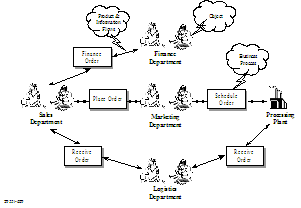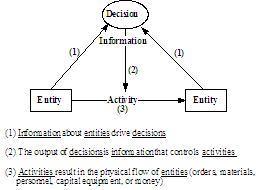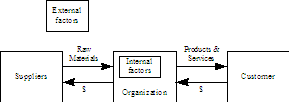BPI Technique - Business Modeling - BM
Description
-
A visual representation of a complete organizational system, including suppliers and customers, which is used as a unifying focal point, when communicating about the business throughout the organization.
A visual representation of a complete organizational system, including suppliers and customers, which is used as a unifying focal point, when communicating about the business throughout the organization.
When to Use
-
There is an established a standardized Entity-level Business Model, which is used as the starting point for business modeling.
-
The activities performed in creating the Entity-level Business Model often generate enough information to develop an Organisations value chain (Value Chain Analysis). If sufficient detail is not gathered, a decision is made to do further, more detailed business modeling (Holistic Business Model).
-
Questions answered by Business Modeling are: How does the complete business system work? How well does each business process contribute to the overall goals of the business system? How well do the business processes work together, when contrasted with the vision of the business system? Are the existing business processes positioned for success?
There is an established a standardized Entity-level Business Model, which is used as the starting point for business modeling.
The activities performed in creating the Entity-level Business Model often generate enough information to develop an Organisations value chain (Value Chain Analysis). If sufficient detail is not gathered, a decision is made to do further, more detailed business modeling (Holistic Business Model).
Questions answered by Business Modeling are: How does the complete business system work? How well does each business process contribute to the overall goals of the business system? How well do the business processes work together, when contrasted with the vision of the business system? Are the existing business processes positioned for success?
Approach
-
Choose the type of business model to be used, since each technique has its own approach.
-
Construct the selected business model.
-
Evaluate and review the model with client management, and revise it as necessary.
A number of techniques for secondary business models are identified here: Business System Model, Information Business Model and Interface Maps.
Choose the type of business model to be used, since each technique has its own approach.
Construct the selected business model.
Evaluate and review the model with client management, and revise it as necessary.
Business System Model
-
Focuses on physical flows and how they relate to entities such as people, places and things. Business system models are typically icon-based and may or may not explicitly describe information flows.
-
Definitions
-
Business System: a set of logically related business processes designed to accomplish a set of business goals
-
Business Process: a set of logically related tasks
-
Task: an activity or set of logically related activities
-
Objects: real people, places, things and organizations related by business processes and tasks. All business processes and tasks begin and end by interacting with objects
-
Information and Product Flows:when, where and how information and products
-
Graphically, business systems are decomposed into business processes, and business processes are decomposed into tasks. In a business system, people, places and things are related to each other by the processes in which they are involved. By consistently making all objects nouns and all business processes verb phrases, the relationships between objects begin to read like sentences.

-
After the models are drawn, data are collected on the way that information and products flow throughout the system. The type of data selected for collection should mirror the most important aspects of the business system.
-
The way information is passed (e.g. electronically)
-
The way products are passed (e.g. truck)
-
The time it takes for one unit to pass from point to point
-
How often information and products are passed
-
The volume of information and products passed per unit time
-
The way quality is measured
-
The financial costs involved
-
The following steps are taken to complete a business system model.
-
List the objects in the business system(e.g. marketing, production, sales).
-
Graphically map in the business processes, since they describe the relationships between the objects of the business system (e.g. place order, finance order, ship order, ship order).
-
Review the model for consistency in object and business-process descriptions.
-
Ask the following questions.
-
Do all objects appear as nouns?
-
Do all the business processes appear as verb phrases?
-
Are all the objects parallel in size and importance?
-
Are all the business processes parallel in size and importance?

Focuses on physical flows and how they relate to entities such as people, places and things. Business system models are typically icon-based and may or may not explicitly describe information flows.
Definitions
- Business System: a set of logically related business processes designed to accomplish a set of business goals
- Business Process: a set of logically related tasks
- Task: an activity or set of logically related activities
- Objects: real people, places, things and organizations related by business processes and tasks. All business processes and tasks begin and end by interacting with objects
- Information and Product Flows:when, where and how information and products
Graphically, business systems are decomposed into business processes, and business processes are decomposed into tasks. In a business system, people, places and things are related to each other by the processes in which they are involved. By consistently making all objects nouns and all business processes verb phrases, the relationships between objects begin to read like sentences.
After the models are drawn, data are collected on the way that information and products flow throughout the system. The type of data selected for collection should mirror the most important aspects of the business system.
- The way information is passed (e.g. electronically)
- The way products are passed (e.g. truck)
- The time it takes for one unit to pass from point to point
- How often information and products are passed
- The volume of information and products passed per unit time
- The way quality is measured
- The financial costs involved
The following steps are taken to complete a business system model.
- List the objects in the business system(e.g. marketing, production, sales).
- Graphically map in the business processes, since they describe the relationships between the objects of the business system (e.g. place order, finance order, ship order, ship order).
- Review the model for consistency in object and business-process descriptions.
- Ask the following questions.
- Do all objects appear as nouns?
- Do all the business processes appear as verb phrases?
- Are all the objects parallel in size and importance?
- Are all the business processes parallel in size and importance?
Information Business Model
-
Focuses predominantly on information flows, and how they relate to entities, organizational locations, decision points, and physical flows. The model highlights the cross functional nature of processes and enables model building in various levels of detail. It provides a process flow orientation that is meaningful to business people and may be icon-based for graphical ease of interpretation.


Focuses predominantly on information flows, and how they relate to entities, organizational locations, decision points, and physical flows. The model highlights the cross functional nature of processes and enables model building in various levels of detail. It provides a process flow orientation that is meaningful to business people and may be icon-based for graphical ease of interpretation.
Interface Map
-
Used to provide a big picture perspective of the business system. Additionally, the maps provide a "top down" view of the relationship between major functions, and they facilitate the grouping of business functions into processes.
-
The following are the steps involved in constructing an interface map.
-
Map departments or functions by geographical (or logical) locations
-
Identify major output/input for each department
-
Specify any external departments or entities, including suppliers and customers
-
Draw linkages to/from functions
-
Draw boundaries of processes
-
Below is a highest level example of the above principle

Example: Interface Map Business Model for a generic company

Used to provide a big picture perspective of the business system. Additionally, the maps provide a "top down" view of the relationship between major functions, and they facilitate the grouping of business functions into processes.
The following are the steps involved in constructing an interface map.
- Map departments or functions by geographical (or logical) locations
- Identify major output/input for each department
- Specify any external departments or entities, including suppliers and customers
- Draw linkages to/from functions
- Draw boundaries of processes
Below is a highest level example of the above principle
Guidelines
-
Use the same naming conventions as described in business system modeling. Use actual department names and geographical, physical locations. Be cautious of the level of detail you choose to describe. Stay at the high level, by identifying the major (key) inputs and outputs of each object.
-
Base the selection of a modeling technique on what the client team can understand, comprehend and see as valuable. Utilize simple frameworks (i.e. just to communicate understanding), and use the type of business model that will be the most easily understood in the organization
-
Be aware that risk exists in not selecting the appropriate business model for the client/industry in question. This can lead to too much detail or concern about absolute accuracy. Select the model that speaks to the level of detail, which is most natural for client executives. Simple techniques work best. Do not try to make the process too complex.
-
Set concrete time limits for the completion of a business model. Recognize when to stop adding detail or refining the model. Ensure that the client team understands at the beginning of this task that the model is a starting point for other activities, and that the scope and definition of business processes will probably be refined and modified in later steps.
-
Realize that the business model provides a picture of the organization, as it currently exists. Key decision points are highlighted, as well as crossfunctional information and physical material flows. Do not restrict the model by current organizational boundaries, and focus attention on key processes and information flows.
-
Know that it is common for very crossfunctional processes (e.g., order management or product development and introduction) to cross value chain boundaries.
Use the same naming conventions as described in business system modeling. Use actual department names and geographical, physical locations. Be cautious of the level of detail you choose to describe. Stay at the high level, by identifying the major (key) inputs and outputs of each object.
Base the selection of a modeling technique on what the client team can understand, comprehend and see as valuable. Utilize simple frameworks (i.e. just to communicate understanding), and use the type of business model that will be the most easily understood in the organization
Be aware that risk exists in not selecting the appropriate business model for the client/industry in question. This can lead to too much detail or concern about absolute accuracy. Select the model that speaks to the level of detail, which is most natural for client executives. Simple techniques work best. Do not try to make the process too complex.
Set concrete time limits for the completion of a business model. Recognize when to stop adding detail or refining the model. Ensure that the client team understands at the beginning of this task that the model is a starting point for other activities, and that the scope and definition of business processes will probably be refined and modified in later steps.
Realize that the business model provides a picture of the organization, as it currently exists. Key decision points are highlighted, as well as crossfunctional information and physical material flows. Do not restrict the model by current organizational boundaries, and focus attention on key processes and information flows.
Know that it is common for very crossfunctional processes (e.g., order management or product development and introduction) to cross value chain boundaries.

No comments :
Post a Comment